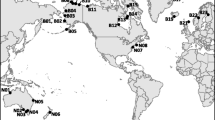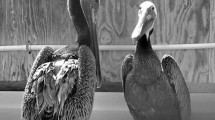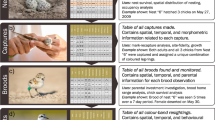Abstract
The marking of individual birds has a long history in ornithology. This inexpensive and simple practice has been used to shed light on migration, behavior, and age-specific survival and recruitment. However, problems associated with markers and tags have often been overlooked. Wing tags have been used for over 40 years on frigatebirds, but their effects on this family of highly aerial seabirds have not been examined. Following higher than expected nest failure of treatment birds in the previous breeding season, we designed a study to test the impact of wing tagging and other standard capture and sampling methods on the nest success of Magnificent Frigatebirds (Fregata magnificens). Twelve nests were assigned to each of various band, measure, bleed, wing tag, and control treatments in the 2010/2011 breeding season on Barbuda, West Indies. We modeled nest fates using generalized linear models. Wing tags had a substantial negative effect on pre-fledging nest success, which was 42 % (10/24) for control nests, 39 % (14/36) for all non wing-tagged treatments, and 15 % (7/48) for wing-tagged treatments. We also conducted two meta-analyses, with different effect size calculations, to explore the general impact of wing and patagial tags on all birds. Our log odds ratio model showed a significant effect on survival and hatch and nest success, while our standardized mean difference model dealing largely with outcomes of behavioral, condition, and reproductive parameters (e.g., number of chicks and hatch date) showed no difference between marked and control birds. We consider possible mechanisms by which wing tags might contribute to lower nest success in frigatebirds, and propose that alternative markers be considered carefully before being applied to any species.
Zusammenfassung
Flügelmarkierungen sind möglicherweise problematisch: eine Fallstudie und Metaanalyse der Auswirkungen von Flügelmarkierungen
In der Ornithologie hat die Markierung einzelner Vögel eine lange Tradition. Als preiswerte und einfache Methode dient sie schon seit langem dazu, Erkenntnisse über den Vogelzug, das Verhalten und das Überleben und die Fortpflanzung zu gewinnen. Dabei sind aber Probleme, die aus den solchen Markierungen am Vogel resultierten, oft vernachlässigt worden. Seit mehr als 40 Jahren werden bei Fregattvögeln Flügelmarkierungen eingesetzt, aber deren Auswirkungen auf diese ausgesprochen flugintensiven Vögel wurden nie untersucht. Nachdem wir bei markierten Vögeln nach einer Brutsaison einen schlechteren Bruterfolg als erwartet beobachtet hatten, arbeiteten wir eine Studie aus zur Untersuchung der Auswirkungen von Flügelmarkierungen und anderer Fang- und Markierungsmethoden auf den Bruterfolg von Prachtfregattvögeln (Fregata magnificens). In der Brutsaison 2010/2011 wurden auf Barbuda, einer Insel der Kleine Antillen, zwölf Nester für je eine von mehreren Markierung- und Messmethoden sowie für Kontrollbehandlungen ausgewählt. Die weitere Entwicklung der einzelnen Nester wurde anhand linearer Modelle modelliert. Danach hatten Flügelmarkierungen einen substantiell negativen Effekt auf den Bruterfolg während der Zeit vor dem Flüggewerden: 42 % (10/24) bei den Kontrollnestern, 39 (14/36) bei allen Behandlungen außer Flügelmarkierung und 15 % (7/48) bei den Nestern mit Flügelmarkierungen. Außerdem führten wir zwei Metaanalysen für unterschiedliche Effektstärkenberechnungen durch, um den generellen Einfluss von Flügelmarkierungen zu untersuchen. Das von uns eingesetzte logarithmische Quotenverhältnis-Modell („log odds ratio model“) zeigte einen signifikanten Effekt auf den Überlebens- und Schlüpferfolg, während das standardisierte „mean difference“-Modell, das in erster Linie für Messungen von Verhaltens- und Fortpflanzungsparametern eingesetzt wird, keinen Unterschied zwischen den markierten und den Kontrollvögeln zeigte. Wir denken, dass es möglicherweise Mechanismen gibt, die bei an den Flügeln markierten Fregattvögeln zu einem geringeren Bruterfolg führen, und wir empfehlen, alternative Markierungen bei jeder Vogelart vor einer Anbringung sorgfältig zu prüfen.





Similar content being viewed by others
References
Bartelt GA, Rusch DH (1980) Comparison of neck bands and patagial tags for marking American Coots. J Wildl Manag 44:236–241
Boag DA, Watson A, Parr R (1975) Patagial streamers as markers for Red Grouse chicks. Bird-Band 46:248
Bowlin MS, Henningsson P, Muijres FT, Vleugels RHE, Liechti F, Hedenström A (2010) The effects of geolocator drag and weight on the flight ranges of small migrants. Methods Ecol Evol 1:398–402
Brosi BJ, Biber EG (2009) Statistical inference, Type II error, and decision making under the US Endangered Species Act. Front Ecol Environ 7:487–494. doi:10.1890/080003
Brua RB (1998) Negative effects of patagial tags on Ruddy Ducks. J Field Ornithol 69:530–535
Brubeck MV, Thompson BC, Slack RD (1981) The effects of trapping, banding, and patagial tagging on the parental behavior of Least Terns in Texas. Colon Waterbirds 4:54–60
Bustness JO, Erikstad KE (1990) Effects of patagial tags on laying date and egg size in Common Eiders. J Wildl Manag 54:216–218
Calvo B, Furness RW (1992) A review of the use and the effects of marks and devices on birds. Ringing Migr 13:129–151
Culik BM, Wilson RP, Bannasch R (1993) Flipper-bands on penguins: what is the cost of a life-long commitment? Mar Ecol Prog Ser 98:209–214
Curtis PD, Braun CE, Ryder RA (1983) Visibility, wear, and effects on survival of Band-tailed Pigeons. J Field Ornithol 54:381–386
Dearborn DC, Anders AD, Schreiber EA, Adams RMM, Mueller UG (2003) Inter-island movements and population differentiation in a pelagic seabird. Mol Ecol 12:2835–2843
Dearborn DC, Anders AD, Williams JB (2005) Courtship display by great frigatebirds, Fregata minor: an energetically costly handicap signal? Behav Ecol Sociobiol 58:397–406. doi:10.1007/s00265-005-0933-7
Diamond AW (1972) Sexual dimorphism in breeding cycles and unequal sex ratio in Magnificent Frigate-birds. Ibis 114:395–398
Diamond AW (1973) Notes on the breeding biology and behaviour of the Magnificent Frigatebird. Condor 75:200–209
Diamond AW (1975) Biology and behaviour of frigatebirds Fregata spp. on Aldabra Atoll. Ibis 117:302–323
Diamond AW, Schreiber EA (2002) Magnificent Frigatebird (Fregata magnificens). In: Poole A (ed) Birds of North America Online. Cornell Lab of Ornithology, Ithaca. doi:10.2173/bna.601
Green AJ, Fuentes C, Vázquez M, Viedma C, Ramón N (2004) Use of wing tags and other methods to mark Marbled Teal (Marmaronetta angustirostris) in Spain. Ardeola 51:191–202
Hannon SJ, Jönsson I, Martin K (1990) Patagial tagging of juvenile willow ptarmigan. Wildl Soc Bull 18:116–119
Hedges SB, Sibley CG (1994). Molecules vs. morphology in avian evolution: the case of the ‘‘pelecaniform’’ birds. Proc Natl Acad Sci USA 91:9861–9865
Hedges LV, Vevea JL (1998) Fixed and random-effects models in meta-analysis. Psychol Methods 3:486–504
Howe MA (1980) Problems with wing tags: evidence of harm to willets. J Field Ornithol 51:72–73
Jackson JR (1982) Effect of wing tags on renesting interval in Red-winged Blackbirds. J Wildl Manag 46:1077–1079
Kinkel LK (1989) Lasting effects of wing tags on Ring-billed gulls. Auk 106:619–624
Kushlan JA (2009) Status and conservation of the Magnificent Frigatebird (Fregata magnificens) on Barbuda, West Indies. J Caribb Ornithol 22:41–43
Lank D (1979) Dispersal and predation rates of wing-tagged semipalmated Sandpipers Calidris pusilla and an evaluation of the technique. Wader Study Group Bull 27:41–46
Maddock MN, Gearing DJ (1994) Effect of patagial tags on cattle egrets. Corella 18:1–7
Madsen V, Valkiūnas G, Iezhova TA, Sanchez M, Osorno JL (2007) Testosterone levels and gular pouch coloration in courting Magnificent Frigatebird (Fregata magnificens): variation with age-class, visited status and blood parasite infection. Horm Behav 51:156–163
McKilligan NG, Reimer DS, Seton DHC, Davidson DHC, Willows JT (1993) Survival and seasonal movements of the cattle egret in eastern Australia. Emu 93:79–87
Morgenweck RO, Marshall WH (1977) Wing marker for American Woodcock. Bird-Band 48:224–227
Nelson JB (1975) The breeding biology of frigatebirds: a comparative review. Living Bird 14:113–155
Osorno JL (1996) Evolution of breeding behavior in the Magnificent Frigatebird: copulatory pattern and parental investment. PhD dissertation, University of Florida, Gainesville
Osorno JL (1999) Offspring desertion in the Magnificent Frigatebird: are males facing a trade-off between current and future reproduction? J Avian Biol 30:335–341
Passos C, Navarro J, Giudici A, González-Solís J (2010) Effects of extra mass on the pelagic behavior of a seabird. Auk 127:100–107
Pennycuick CJ (1983) Thermal soaring compared in three dissimilar tropical bird species, Fregata magnificens, Pelecanus occidentalis and Coragyps atratus. J Exp Biol 102:307–325
Pennycuick CJ (2008) Modelling the flying bird. Academic, Amsterdam
Phillips RA, Xavier JC, Croxall JP (2003) Effects of satellite transmitters on albatrosses and petrels. Auk 120:1082–1090
Pineau O, Hafner H, Kayser Y (1992) Influence of capture and wing tagging on the little egret (Egretta garzetta) during the breeding season. Rev Ecol (Terre Vie) 47:199–204
Quinn G, Keough M (2002) Experimental design and data analysis for biologists. Cambridge University Press, Cambridge
R Development Core Team (2008) R: a language and environment for statistical computing. R Foundation for Statistical Computing, Vienna, Austria. ISBN 3-900051-07-0, URL http://www.R-project.org
R Development Core Team (2011) R: a language and environment for statistical computing. R Foundation for Statistical Computing, Vienna, Austria. ISBN 3-900051-07-0, URL http://www.R-project.org
Saraux C, Le Bohec C, Durant JM, Viblanc VA, Gauthier-Clerc M, Beaune D, Park Y, Yoccoz NG, Stenseth NC, Le Maho Y (2011) Reliability of flipper-banded penguins as indicators of climate change. Nature 469:203–206
Saunders DA (1988) Patagial tags: do benefits outweigh risks to the animal? Aust Wildl Res 15:565–569
Schreiber EA (1999) Problems encountered when banding frigatebirds and boobies. Waterbirds 22:310–313
Seamans TW, Beckerman S, Hartmann J, Rader JA, Blackwell BF (2010) Reporting difference for colored patagial tags on Ring-billed gulls. J Wildl Manag 74:1926–1930. doi:10.2193/2009-304
Smallwood JA, Natale C (1998) The effect of patagial tags on breeding success in American Kestrels. North Am Bird Bander 23:73–78
Southern LK, Southern WE (1985) Some effects of wing tags on breeding rRing-billed gulls. Auk 102:38–42
Sterne JAC, Becker BJ, Egger M (2005) The funnel plot. In: Rothstein HR, Sutton AJ, Borenstein M (eds) Publication bias in meta-analysis: prevention, assessment, and adjustments. Wiley, Chichester
Stewart G (2010) Meta-analysis in applied ecology. Biol Lett 6:78–81
Viechtbauer W (2010) Conducting meta-analysis in R with the metafor package. J Stat Soft, 36:1–48. URL http://www.jstatsoft.org/v36/i03
Zuberogoitia I, Arroyo B, O'Donoghue B, Zabala J, Martínez JE, Murphy SG (2012) Standing out from the crowd: are patagial wing tags a potential predator attraction for harriers (Circus spp.)? J Ornithol. doi:10.1007/s10336-012-0842-2
Zwickel FC (1983) Factors affecting the return of young blue grouse to breeding range. Can J Zool 61:1128–1132
Acknowledgments
Funding was provided by Natural Sciences and Engineering Research Council of Canada Discovery grant number 170521-2009 to A.W.D., and S.A.T. was funded by a University of New Brunswick William S. Lewis Doctoral Fellowship. Research was conducted under permits from the Barbuda Council and Antigua and Barbuda National Parks, and with kind permission of the Environmental Awareness Group of Antigua. We wish to thank the field assistants who contributed to this project: Sarah Chisholm, Marie-Paule Godin, Geoff Holroyd, James Hudson, Julie McKnight, Rebecca Standen, Josh Sayers, Helen Trefry, Phil Trefry, and Erin Whidden. Jason Addison, Steve Heard, and James Hudson provided useful comments on earlier drafts. Procedures were conducted in accordance with the guidelines for the ethical use of animals and research set forth by the Canadian Council on Animal Care Guidelines and Policies at the University of New Brunswick, under Protocol 10045.
Author information
Authors and Affiliations
Corresponding author
Additional information
Communicated by A. Hedenström.
Electronic supplementary material
Below is the link to the electronic supplementary material.
Rights and permissions
About this article
Cite this article
Trefry, S.A., Diamond, A.W. & Jesson, L.K. Wing marker woes: a case study and meta-analysis of the impacts of wing and patagial tags. J Ornithol 154, 1–11 (2013). https://doi.org/10.1007/s10336-012-0862-y
Received:
Revised:
Accepted:
Published:
Issue Date:
DOI: https://doi.org/10.1007/s10336-012-0862-y




